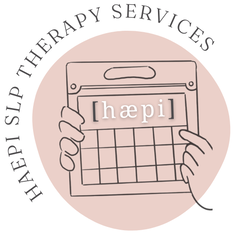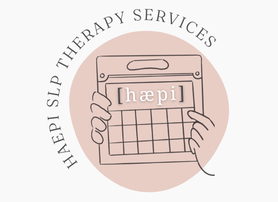|
Wondering how you can adapt your language targets when working with gestalt language processors vs analytic language processors? (Not sure if your child is a GLP or an ALP? Click here to find out!)
Here are some of my top tips to help with modelling language for both GLPs and ALPs:
by Halle Demchuk, SLPPaediatric SLP | GLP-Trained Clinician | Owner of HAEPI SLP
To all Speech-Language Professionals: if you've ever wondered how you were going to model AAC to a child with a device during a virtual session, I hear you!
We know AAC is best modelled in natural environments and during play, and while most SLPs have figured out ways to do something resembling play-based therapy over Zoom, AAC can feel like a whole other ballgame. So, I wanted to show you one of my favourite resources to use: music videos and songs! This is completely free using YouTube. I'll sometimes do a Boom Deck first or something that teaches the target words (e.g., we learned "go" and "stop" in a Boom Deck game) and then follow that up with "singing" along to a song. I have an iPad Pro that I like to use for modelling as it's quite a bit bigger and therefore easier to see on Zoom while the video is playing. I also like to use this with "Head, Shoulders, Knees, and Toes" and "5 Little Ducks." Just because our kids may live in hard to reach places (like in remote Northern communities), this doesn't mean we can't still do play-based AAC virtually... we just need to be creative! by Halle Demchuk, SLPPaediatric SLP | GLP-Trained Clinician | Owner of HAEPI SLP
As SLPs, we have the opportunity to embed social-emotional learning into traditional language therapy, and a holistic approach to speech-language pathology would encourage us to take it!
An easy way we can do this is by building on the concepts that we are already teaching. For instance, we often target "wh questions" (e.g., who, what, when, where, why), but we don't always take the step further to delve into how we can *feel* these concepts in our bodies, and how we can express them with our emotions. Example: In this reel, I'm working on 'when' questions with a group virtual session. Notice how I'm using the SLP topic to talk about social-emotional learning and identifying emotions. This is not an activity in identifying good vs. bad emotions, but simply highlighting different strategies that we can use when we feel certain things. by Halle Demchuk, SLPPaediatric SLP | GLP-Trained Clinician | Owner of HAEPI SLP
Although I focus a lot of my content on AAC and GLP, I also LOVE working with children with speech sound difficulties, including articulation difficulties.
Since taking the Play-based Speech Therapy Course by @anna.dee.slp and @wordsmatterslp, my articulation sessions have become mostly play-based and I have noticed increased engagement and motivation, which has led to increased success (don't you learn better too when you're enjoying it?!). I also learned that articulation therapy can be *more* successful by including fewer targets, including multiple target sounds in one activity, and using targets and activities that have more carry-over to the child's everyday life. Not to mention how movement can help regulate kids while learning! (Mini items are from @speechtreeco, which I may have a slight obessession with...) by Halle Demchuk, SLPPaediatric SLP | GLP-Trained Clinician | Owner of HAEPI SLP
All AAC learners (regardless of skill level) need to see what it looks like to communicate using their AAC system in real conversations. Just as we don't expect any child to learn to talk without seeing or hearing the adults around them talking and communicating, *modelling* the use of the AAC device is just as crucial.
Modelling is a fancy term used by SLPs that simply means showing the child how to use the device without expecting or forcing them to copy. The best way to start doing this is by finding a word or two on their AAC system or device for each sentence you want to say, and pressing the symbols as you say the word. Here are some strategies for effective modelling:
While it's important to include fringe words (words with very specific meanings) so children can better describe their world, the best approach when starting AAC is to keep the focus on core words. Then, incorporate personal fringe words as needed to help kids talk about what's important to them. by Halle Demchuk, SLPPaediatric SLP | GLP-Trained Clinician | Owner of HAEPI SLP |
The HAEPI BlogCheck here for HAEPI updates, helpful SLP information, free resources, articles, and more!
Archives
June 2024
Categories
All
|
Empowering Happy Communicators |
get in touch |
Quick Links |
© HAEPI SLP THERAPY SERVICES.
HAEPI SLP Therapy Services is proudly neurodiverse, Indigenous-owned, and woman-operated.



